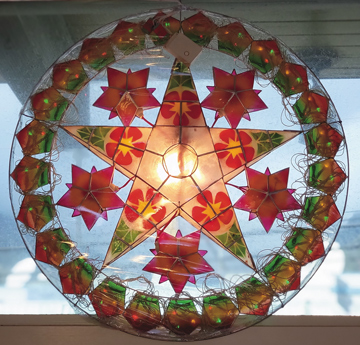
Pasko sa Pinas
Christmas is special and unique in the Philippines because …
Liza A Pierce of “A Maui Blog” | Photos courtesy Liza Pierce
Pasko na naman, o kay tulin ng araw.
Paskong nagdaan tila parang kalian lang … .
If you’re Filipino, chances are you were singing the first two lines of this article as you were reading it. It is one of the most beloved Christmas songs we have in the Philippines. For non-Filipino speaking readers, here is the translation:
It’s Christmas once again, oh how time flies fast!
Previous Christmas seems to just have happened recently … .
Hearing Christmas carols all around Maui these days makes me nostalgic. They make me reminisce Christmas celebrations in the Philippines…
What makes Christmas in the Philippines special and unique? Let me share some of them:

Photo: Keith Bacongco – Creative Commons Wikipedia
1. Longer Christmas Season – For the most part, celebrating Christmas starts in September. Christmas season starts as soon as the first BER months start. BER months? What are BER months you might ask. Well, they are the months ending in BER … SeptemBER, OctoBER, NovemBER and DecemBER. It’s sort of a countdown leading to Christmas and New Year.
Here in the United States, the people are “split.” There are those who celebrate earlier (most likely Filipinos or part Filipinos ) and there are those who adamantly oppose any Christmas celebration until after Thanksgiving. And yes, part of the reason the Christmas season seems to be shorter in the U.S. is because here in the U.S. we celebrate Halloween and Thanksgiving prior to Christmas.

Photo: Liza Pierce
2. Christmas Caroling – “Sa may bahay ang aming bati, Merry Christmas na malualhati …” This is another common Filipino Christmas song, often sung during caroling. Christmas Caroling is a beloved tradition in the Philippines. This usually starts on December 16 (same as the Simbang Gabi which we will discuss later), it is a Christmas tradition for groups of people (often the neighborhood kids) to gather and go around neighborhood singing Christmas Carols in front of each home. In return, the owners of the home gives money—sometimes a gift or food—but the most common is money. The kids’ musical instruments are a homemade tambourine—out of soda caps—and homemade maracas and drums.
For me, this is one of the Filipino Christmas traditions I miss while living here in the U.S. I miss hearing the voices of children singing “We Wish You a Merry Christmas,” “Feliz Navidad” and the “Thank you” song after we give them the money. I miss the laughter of the kids, especially when they mischievously sing the “Thank you, ang babarat ninyo” song for those who don’t give money. You Filipinos remember that, right?
In addition to Christmas Carols, the start of the celebration also lines up with beloved Christmas songs like Jose Marie Chan’s “Christmas in our Hearts” and Gary Valenciano’s “Pasko na Sinta ko.”

Photo: Alfredo G. Evangelista
3. Simbang Gabi – Also known as Misa De Gallo, Simbang Gabi is one of the oldest Christmas traditions in the Philippines. People wake at dawn and attend mass at their local churches as early as 4 a.m.! Simbang Gabi is equivalent to celebrating Advent here in the U.S. It is a series of early masses starting December 16 to December 24th which is Christmas Eve. The Christmas Eve Mass is held at 12 midnight instead of 4 a.m. This is to celebrate Christ’s birth in the middle of the night. After the Christmas Eve mass, families and friends gather for Noche Buena.

Photo: Alfredo G. Evangelista
4. Noche Buena and Filipino Christmas Food – Noche Buena is a dinner feast after the Christmas Eve Service. Yes, we eat at midnight. Food served during the Noche Buena are special. It’s a big celebration with special cuisines like lechon (roasted pig), Queso de Bola and Christmas ham and many more special side dishes and desserts like halaya (ube) and leche flan. (This is a bountiful Thanksgiving dinner here in the U.S.) Now prior to Noche Buena, there are also traditional Christmas Filipino Foods such as bibingka and puto bungbong.
5. Parol and other Christmas Decorations. There is no shortage of Christmas decorations in the Philippines including Christmas Trees, Santa Claus, Belen (Nativity Scene) but one thing that stands out and is unique to the Philippines are the parols. Parols are Christmas lanterns. Traditionally made with colorful paper and bamboo sticks shaped like a five-pointed star. Displaying parols in the homes, schools, business establishments and streets signifies the spirit of Christmas. Parols now come in many shapes and sizes.
There are many more reasons that make Christmas in the Philippines special and unique to share but I will stop here for now. For those of us who have children who are born in the U.S. and the children have not been in the Philippines and have not experienced Christmas in the Philippines, it is important we impart and continue these traditions in our homes. What Christmas Filipino traditions do you continue here in America?
From all of us at The Fil-Am Voice, Maligayang Pasko at Manigong Bagong Taon!
 Liza Pierce of A Maui Blog is an Interactive Media Strategist in Hawai‘i. She started blogging in 2006 and she loves talking story online and spreading Aloha around the world. She’s been living on Maui since 1994 and considers Maui her home. A wife, a mother, a friend…and so much more. She loves Jesus; Maui Sunsets Catcher; Crazy About Rainbows; End Alzheimer’s Advocate. Her life is full and exciting here on the island of Maui. Liza is currently the Interactive Media Strategist with Wailea Realty Corp.
Liza Pierce of A Maui Blog is an Interactive Media Strategist in Hawai‘i. She started blogging in 2006 and she loves talking story online and spreading Aloha around the world. She’s been living on Maui since 1994 and considers Maui her home. A wife, a mother, a friend…and so much more. She loves Jesus; Maui Sunsets Catcher; Crazy About Rainbows; End Alzheimer’s Advocate. Her life is full and exciting here on the island of Maui. Liza is currently the Interactive Media Strategist with Wailea Realty Corp.
